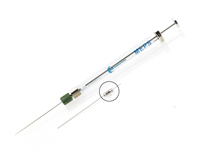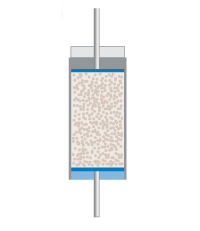
Micro Extraction by Packed Sorbent (MEPS)
 Micro Extraction by Packed Sorbent (MEPS) is a new development in the field of sample preparation by Solid Phase Extraction (SPE). MEPS performs the same function as SPE, but with some significant differencies:
Micro Extraction by Packed Sorbent (MEPS) is a new development in the field of sample preparation by Solid Phase Extraction (SPE). MEPS performs the same function as SPE, but with some significant differencies:
- MEPS works with much smaller sample amount (as small as 10µL) than full scale SPE
- MEPS can be fully automated – the sample processing, extraction and injection steps are performed on-line using the same syringe
- MEPS is applicable to GC and LC
- Significantly reduces the volume of solvents and sample needed
 The MEPS product consists of two parts, the MEPS Syringe and the MEPS Barrel Insert and Needle Assembly (BIN). The BIN contains the SPE phase, and is built into the syringe needle. The BIN is used with a 100µL or 250µL gas tight MEPS syringe that allows fluid handling at normal SPE pressures. When the BIN is exhausted, or another phase is required, the BIN is easily exchanged by simply unscrewing the locking nut and removing/replacing the BIN.
The MEPS product consists of two parts, the MEPS Syringe and the MEPS Barrel Insert and Needle Assembly (BIN). The BIN contains the SPE phase, and is built into the syringe needle. The BIN is used with a 100µL or 250µL gas tight MEPS syringe that allows fluid handling at normal SPE pressures. When the BIN is exhausted, or another phase is required, the BIN is easily exchanged by simply unscrewing the locking nut and removing/replacing the BIN.
Sample Size and Sensitivity
Sample volumes as small as 10µL can be used or larger samples, 1mL or more, may be concentrated by taking multiple aliquots of 100µL or 250µL.
Automation
The ability to prepare and inject samples on-line using a single device reduces sample processing time and the need for operator intervention. Typical BIN life is conservatively about 40-100 samples but actual life is dependent on the sample matrix. The small quantity of phase in the MEPS BIN can be easily and effectively washed between samples which removes the possibility of carry-over. This process simply is not practical on conventional SPE.
Flexibility and easy to use
MEPS BINs are available in a variety of common SPE phases. The dimensions of the sorbent bed ensure that the sorbent performance remains identical to conventional SPE devices used for extraction of similar samples.
Sample preparation for complex biological samples is readily adapted to MEPS and reduces the volume of sample and reagents required for extraction when compared with conventional SPE and other "micro extraction procedures".
The MEPS approach to sample preparation is suitable for reversed phases, normal phases, mixed mode and ion exchange chemistries. Because MEPS BINs can be used for sample volumes as small as 10µL it makes them particularly well suited to on-line use with LC-MS analysis of volume limited samples.
![]()
The current range of syringes may be used manually or when used in Thermo Scientific, CTC Analytics, HTA 300APlus and Varian 8400 auto-injectors require no modification of the syringe mount. BINs are available in needle styles to suit LC and GC applications. Needles are packed in a sealed blister pack of 5 needles to ensure their integrity.
How does MEPS perform?
Sample preparation for complex biological samples is readily adapted to MEPS and reduces the volumes of sample and reagents required for extraction when compared with conventional SPE and other "micro extraction procedures". Table below compares the accuracy, precision, limits of detection and extraction time of MEPS with two other μSPE techniques, SPME and SBSE (Stirring Bar Sorbent Extraction) for 5 different PAH's extracted from water. The results from the MEPS and SBSE techniques are significantly better than SPME but MEPS processes each sample 100 times faster than SBSE.
Comparison of accuracy and precision of MEPS, SPME and SBSE for the analysis of PAH's in water
| Compound | Accuracy (%) | Precision (% RSD) | Extraction time (min) | ||||||
|---|---|---|---|---|---|---|---|---|---|
| MEPS | SPME | SBSE | MEPS | SPME | SBSE | MEPS | SPME | SBSE | |
| Anthracene | 84 | 81 | 99 | 12 | 3 | 6 | 2 | 30 | 200 |
| Chrysene | 107 | 81 | 100 | 1 | 4 | 5 | 2 | 30 | 200 |
| Fluoranthene | 100 | 84 | 100 | 9 | 4 | 4 | 2 | 30 | 200 |
| Fluorene | 103 | 96 | 97 | 5 | 5 | 4 | 2 | 30 | 200 |
| Pyrene | 115 | 86 | 100 | 7 | 3 | 3 | 2 | 30 | |
M. Abdel-Rehim / J. Chromatog. A 1114 (2006) 234-238
Accuracy and Precision
Enclosed table summarizes the precision and accuracy results obtained analyzing Ropivacaine by four sample preparation methods: MEPS, Liquid-Liquid Extraction (LLE), conventional SPE and Solid Phase Microextraction (SPME). Compared to SPME, also a μSPE technique, MEPS demonstrated better precision and accuracy while taking significantly less time to process each sample.
Comparison of accuracy and precision between MEPS and other methods for ropivacaine (local anesthetics)
| Method | LOD (nM) | Accuracy (%) | Precision (% RSD) | Handling time |
|---|---|---|---|---|
| MEPS / GC-MS | 2 | 105 | 5.0 | 1 min |
| LLE / GC-MS | 2 | 101 | 3.8 | 20 min |
| SPE / LC-UV | 100 | 101 | 3.0 | 20 min |
| SPME / GC-MS | 5 | 110 | 6.3 | 40 min |
M. Abdel-Rehim / J. of Chromatography B, 801 (2004) 317-321





 0
0
 0
0